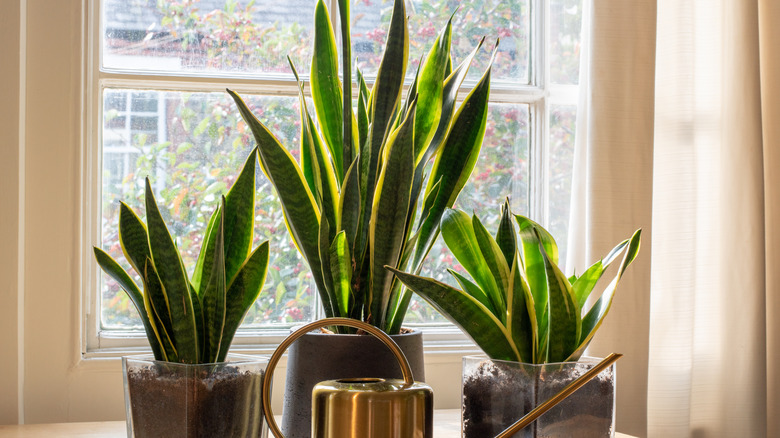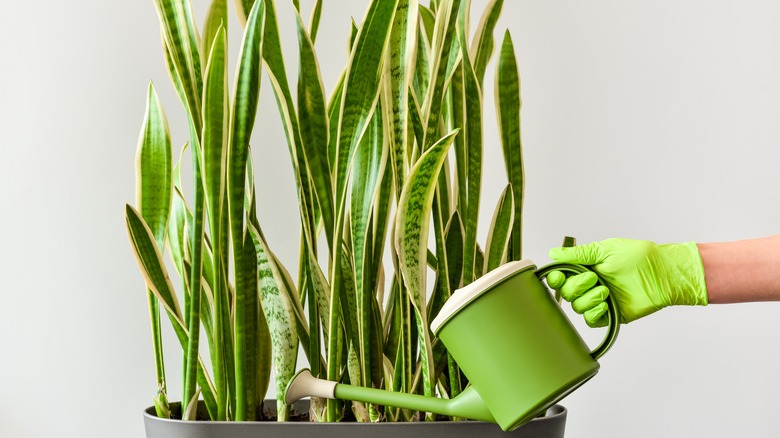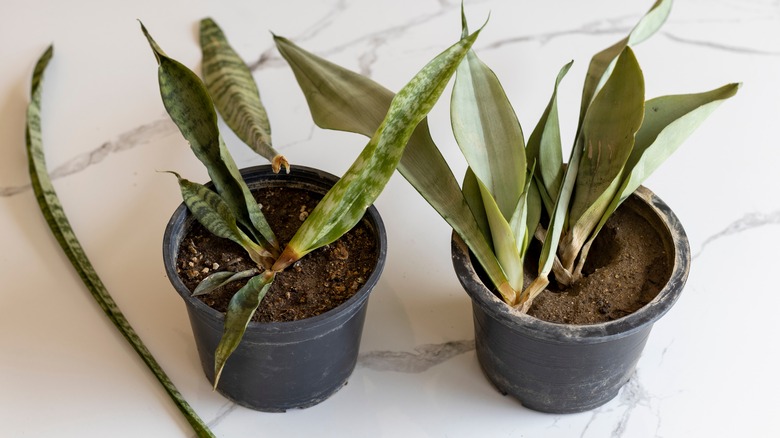4 Pointers For Caring For Your Snake Plant
Dracaena trifasciata, known colloquially as (genus) Sansevieria or snake plant, is a popular houseplant and one of the simplest to care for. There are approximately 70 snake plant varieties, ranging from the 16-inch Sansevieria fischeri to the tallest, Sansevieria cylindrica, which can reach a height of 8 feet. The hardy, adaptable, and resilient snake plant thrives with a minimum of care and attention, and is one of the best-suited plants for indoor life, according to Pennington. In fact, a snake plant is more apt to succumb from too much care, not too little.
The arid terrain of West Africa is home to the familiar succulent, and it will do fine in conditions even slightly replicating its native state. The spiky-leafed plant's modest requirements make it a perfect choice for either a novice or an experienced, but neglectful, grower. Snake plants are gluttons for punishment, needing little attention, but there are still some key pointers regarding their care. Here are four you should keep in mind when caring for your snake plant(s).
1. Over-watering snake plants is taboo
Being a succulent, a Sansevieria holds water in its leaves and roots, making it drought-tolerant. Excessive soil moisture is the Achilles heel of an otherwise nearly indestructible snake plant. It needs to be watered only once every two to four weeks when it's warm and less often in winter, according to Urban Garden Gal.
Filtered water or rainwater at room temperature is ideal, as chlorine is detrimental to the snake plant. Also, be careful not to water the leaves directly. A Sansevieria's soil should be allowed to almost completely dry out between doses of watering. Regulate your watering according to temperature and season, and note that nake plants drink more under warmer, sunnier conditions. Per The Home Depot, insert a finger into the top inch of soil to determine the level of dryness before deciding to water.
Green when healthy, brown or yellow leaves are a possible sign of over-watering, and they may also point to poor drainage. If overly saturated, the swordlike leaves of a vibrant plant will change into soft, mushy, and limp ones, explains Utopia.org. The stems connected to the roots will also darken and become smelly and soggy. Soggy roots will invite bacterial root rot.
Address Sansevieria root rot by removing the root ball and excising afflicted areas. Withhold water and air dry overnight before re-potting in loose soil and watering the plant. If you're able to irrigate the pot from the bottom up, it will prompt a snake plant's roots to grow in a downward manner to stabilize the plant's leaves.
2. Indirect bright light is best for a snake plant
Per The Old Farmer's Almanac, snake plants will thrive in temperature, humidity, and light akin to the southern U.S. Sixty to 85 degrees Fahrenheit is their ideal temperature range. Further, while a popular indoor plant, snake plants can certainly grow outdoors as well; the almanac notes that USDA Zone 8 (or warmer) is suitable for these plants. Snake plants can also withstand wintry conditions in zones 9 to 11, but will suffer from frost. Drafts are harmful, too, and prolonged exposure to the cold will harm the plants' leaves.
Obviously, the variable light and arid conditions of their native Africa is ideal, according to Pennington. To help replicate, situate the plant indoors close to a sunny window where it will be exposed to strong but indirect light. Facing east will give it a good dose of the morning sun, but the durable succulent can even safely sit in a sunless corner, according to Plant Care Today. This said, a snake plant will grow fastest and be more colorful where light is strongest.
Planterina suggests lowering light if you want to discourage plant growth. Note that too abruptly re-positioning a Sansevieria to direct sunlight from low light can be harmful. Do it gradually over a week to avoid shocking it. Sansevieria plants can grow under artificial light, but less vigorously.
Overexposure to sun can result in discolored, withered leaves that become crispy, per mindbodygreen. Insufficient light causes sagging foliage, and regularly dusting a snake plant will emphasize its shininess and allow it to better absorb light.
3. Don't ignore signs of disease or pests
Root rot poses the main threat to a snake plant's well-being. In addition to not over-watering, experts advise replacing the soil at eight- to 12-month intervals to protect the roots from rotting. Though robust and normally requiring minimal care, snake plants can be attacked by pests and weakened by disease. The good news is that most of them respond to treatment, according to Petal Republic.
Southern blight is a virulent fungus that can kill your plant in a week's time. White areas on the leaves are the first sign, which progress and make the foliage wilt, turn a dark brown, and appear to be wet. A remedy is the fungicide methyl bromide. According to Garden Tabs, the blight can be carried on tainted pots, too, so be sure to plant your specimens in new or disinfected ones. Red leaf spot disease is another snake plant ailment responsive to fungicides. Fungus gnats can be eradicated using dish soap and water. Lifestyle media brand mindbodygreen warns against misting a snake plant because the practice may lead to a fungus attack.
4. Choose a soil that will allow for proper drainage
As said, too much water is the bane of a snake plant, and adequate drainage and aeration are essential for maintaining a healthy one. A light, loamy soil, capable of draining efficiently, is considered to be the best choice. Common garden soil, meanwhile, should be avoided. So that a snake plant's roots don't stay submerged in water, creative blog By Brittany Goldwyn recommends a mix of cactus, houseplant, or succulent soil. Adding a layer of perlite, coconut coir, sand, or pebbles will improve drainage as well.
Meanwhile, incorporating pumice or compost will help the soil to retain moisture for roots to absorb. Snake plants are inherently used to their native poor and unyielding soil, so they can get by without fertilizers. If using one, though, it should be nitrate-free. Worm castings or even coffee grounds can be used to fertilize a snake plant. Avoid plastic pots and instead use a terracotta one to ensure good drainage.
If your Sansevieria appears to be doing poorly, consider changing the soil to a cactus soil or succulent one, per The Indoor Nursery, and House Plant 411 offers this tip: To stimulate flowering every few years and also prevent over-watering, keep a snake plant root bound in a small pot with holes for drainage. Expose the plant to brighter light than usual, and your reward will be clusters of creamy, greenish-white flowers on long stems.




